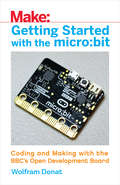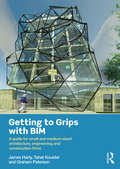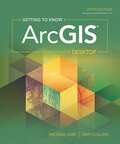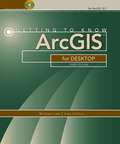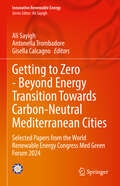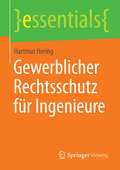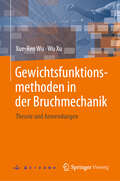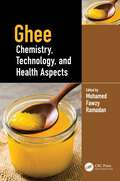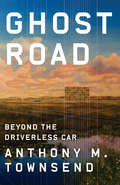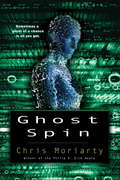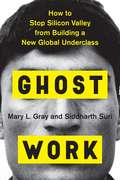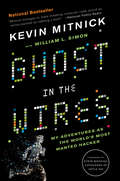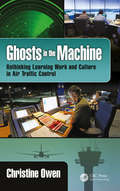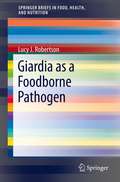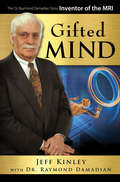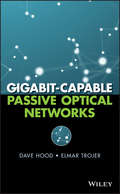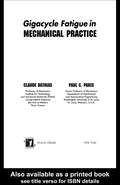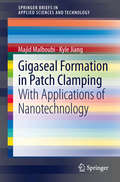- Table View
- List View
Getting Started with the micro: Coding and Making with the BBC's Open Development Board
by Wolfram DonatThe micro:bit, a tiny computer being distributed by the BBC to students all over the UK, is now available for anyone to purchase and play with. Its small size and low power requirements make it an ideal project platform for hobbyists and makers. You don't have to be limited by the web-based programming solutions, however: the hardware on the board is deceptively powerful, and this book will teach you how to really harness the power of the micro:bit. You'll learn about sensors, Bluetooth communications, and embedded operating systems, and along the way you'll develop an understanding of the next big thing in computers: the Internet of Things.
Getting To Know ArcGIS Desktop
by Tim Ormsby Eileen J. Napoleon Robert Burke Carolyn Groessl Laura BowdenGetting to Know ArcGIS Desktop introduces principles of GIS as it teaches the mechanics of using ESRI's leading technology. Key concepts are combined with detailed illustrations and step-by-step exercises to acquaint readers with the building blocks of ArcGIS Desktop including ArcMap", for displaying and querying maps, ArcCatalog", for organizing geographic data, and Model Builder", for diagramming and processing solutions to complex spatial analysis problems. Its broad scope, simple style, and practical orientation make this book an ideal classroom text and an excellent resource for those learning GIS on their own. A data CD for working through the exercises and a fully functioning 180-day trial ArcGIS Desktop 10 software is included.
Getting to Grips with BIM: A Guide for Small and Medium-Sized Architecture, Engineering and Construction Firms
by James Harty Tahar Kouider Graham PatersonWith the UK government‘s 2016 BIM threshold approaching, support for small organisations on interpreting, filtering and applying BIM protocols and standards is urgently required. Many small UK construction industry supply chain firms are uncertain about what Level 2 BIM involves and are unsure about taking first steps towards having BIM capability. As digitisation, increasingly impacts on work practices, Getting to Grips with BIM offers an insight into an industry in change supplemented by practical guidance on managing the transition towards more widespread and integrated use of digital tools to manage the design, construction and whole life use of buildings.
Getting to Know ArcGIS Desktop (Getting to Know ArcGIS)
by Michael Law Amy CollinsBecoming the go-to person for ArcGIS Desktop? Start here. <p><p> This book is a comprehensive introduction to the features and tools of ArcGIS Desktop. Through hands-on exercises, readers will discover, use, make, and share maps with meaningful content. They will also learn how to build geodatabases, query data, analyze geospatial data, and more. The latest edition has been updated to the most current version of ArcGIS Desktop 10.6. <p><p> This book is suited for classroom use, independent study, and as a reference.
Getting to Know ArcGIS for Desktop (Getting to Know ArcGIS Series)
by Michael Law Amy CollinsGetting to Know ArcGIS for Desktop is a workbook for beginners. Its detailed, step-by-step exercises teach you the core functionality of ArcGIS for Desktop software: how to make maps, carry out spatial analysis, and build and edit spatial databases in the context of realistic projects. The exercises are supported by conceptual discussions at the start of each chapter and as needed throughout the book. Getting to Know ArcGIS for Desktop is a hands-on workbook that’s meant to be a practical manual for classroom lab work or on-the-job training. If you have no GIS background, chapter 1 will give you a quick overview. If you have no ArcGIS software experience, chapter 2 will provide a background on Esri GIS software products. The remaining 18 chapters require you to work through software exercises as you read. Each of these chapters contains two to four exercises that focus on a particular GIS task or problem. Many common tasks are covered, including navigating digital maps, finding GIS data online, setting map projections, symbolizing and labeling maps, classifying data, making map layouts, querying maps, analyzing spatial relationships, building spatial databases, editing data, and geocoding addresses. Each new exercise in Getting to Know ArcGIS for Desktop is a fresh starting point, with the maps and data you need already prepared for you. This volume is heavily revised for the third edition. New authors Michael Law and Amy Collins replaced a majority of the datasets for a fresh learning experience. All the exercises were designed for compatibility with ArcGIS 10.1 for Desktop. Although still intended for beginners, the content is no longer limited to the most basic functionality. Some advanced capabilities that are available with Standard and Advanced licenses are discussed. As the chapters progress, instructions and graphics become noticeably more streamlined, assuming increased knowledge and recall by readers as they move forward. Several new features have been added to the book to enhance the learning experience: learning objectives, chapter summaries, questions for critical thinking, software tips, independent-challenge tasks (“On your own"), a glossary of key terms, and navigation tabs.
Getting to Zero - Beyond Energy Transition Towards Carbon-Neutral Mediterranean Cities: Selected Papers from the World Renewable Energy Congress Med Green Forum 2024 (Innovative Renewable Energy)
by Ali Sayigh Antonella Trombadore Gisella CalcagnoThis book contains selected papers from the World Renewable Energy Congress and Network Forum's seventh edition of the biannual Med Green Forum (MGF2024) that highlight opportunities for energy transition based on the principles of efficiency, urban/building integration, and ecology. Contributions explore possible carbon-neutral solutions, technologies, strategies, processes, and policies for Mediterranean cities. The book addresses the transformation in the unique socio-climatic and cultural context of the Mediterranean basin, cities, and architecture, a transversal topic deeply related to social dynamics and new energy landscapes.
Gewerblicher Rechtsschutz für Ingenieure (essentials)
by Hartmut HeringDurch die Erteilung eines Schutzrechtes kann ein Erfinder bzw. Schöpfer einer gewerblich verwertbaren, schöpferischen Leistung für eine bestimmte Zeit das alleinige Verwertungsrecht zugestanden werden. Diese Schutzrechte können technische Schutzrechte sein (Patente und Gebrauchsmuster) oder nicht technische (Geschmacksmuster, Marken und Sortenschutz). Diese Kategorien werden in diesem Band behandelt und insbesondere die Verfahren zur Erteilung der Schutzrechte ausführlich erläutert. Ferner erfolgen Ausführungen zur Verwertung und zur Rechtsverfolgung der Schutzrechte und zur supranationalen Zusammenarbeit auf diesem Gebiet.
Gewichtsfunktionsmethoden in der Bruchmechanik: Theorie und Anwendungen
by Wu Xu Xue-Ren WuDieses Buch bietet einen systematischen und standardisierten Ansatz, der auf der über 30-jährigen Forschungserfahrung der Autoren mit Gewichtsfunktionsmethoden sowie auf der einschlägigen Literatur basiert. Die Bruchmechanik ist in vielen wichtigen technischen Bereichen zu einem unverzichtbaren Werkzeug für die Auslegung und den sicheren Betrieb von schadenstoleranten Strukturen geworden. Der Spannungsintensitätsfaktor - der charakterisierende Parameter des Rissspitzenfeldes - ist die Grundlage der bruchmechanischen Analyse. Die Gewichtsfunktionsmethode ist ein leistungsfähiges Verfahren zur Bestimmung von Spannungsintensitätsfaktoren und Rissöffnungsverschiebungen für komplexe Belastungszustände mit bemerkenswerter Berechnungseffizienz und hoher Genauigkeit.Das Buch stellt den theoretischen Hintergrund der Gewichtsfunktionsmethoden sowie eine Fülle von analytischen Gewichtsfunktionen und Spannungsintensitätsfaktoren für zwei- und dreidimensionale Rissgeometrien vor, von denen viele in nationale und internationale Normen und industrielle Regelwerke eingeflossen sind. Die Genauigkeit der Ergebnisse wird genauestens überprüft, und es werden verschiedene Anwendungsbeispiele gegeben. Das Buch ist somit ein ideales Nachschlagewerk für Studenten, Forscher und Ingenieure, die sich mit dem Bruch und der Ermüdung von Werkstoffen und Strukturen befassen und nicht nur die Spannungsintensitätsfaktoren selbst, sondern auch effiziente und zuverlässige Werkzeuge zu deren Ermittlung benötigen.
Gewinn- und Verlustrechnung (essentials)
by Ekbert HeringDie Jahresabschlüsse von Unternehmen bestehen aus einer Gewinn- und Verlustrechnung sowie einer Bilanz mit Anlagespiegel und Anhang. Unternehmen, die am Kapitalmarkt agieren, müssen Jahresabschlüsse nach IAS/IFRS (IAS: International Accounting Standard; IFRS: International Financial Reporting Standards) vorlegen und eine Kapitalflussrechnung vornehmen. Die Auswertung dieser Zahlenwerke durch entsprechende Kennzahlen gibt den Kunden, den Lieferanten, den eigenen Mitarbeitern, den fremden Geldgebern und der Öffentlichkeit Einblick darüber, ob die Geschäfte des Unternehmens erfolgreich waren oder nicht, ferner können daraus zukünftige Entwicklungschancen und Risiken abgelesen werden.
Gezeiten und Wellen: In Küsteningenieurwesen und Ozeanographie
by Andreas MalcherekDas Fachbuch vermittelt alle Grundlagen der Hydromechanik am Beispiel der Küstengewässer. Der Autor wendet sich dabei an alle Ingenieure, die sich mit Küstenströmungen im Ökosystem Wattenmeer, Klimafolgen, dem Meeresspiegelanstieg, dem Küstenschutz und Offshoreanlagen beschäftigen.
Ghee: Chemistry, Technology, and Health Aspects
by Mohamed Fawzy RamadanGhee (clarified milk fat) is a dairy product composed mainly of milk fat and minor components, such as vitamins, minerals, and enzymes; and butter oil has a bland flavor, whereas ghee has a pleasing flavor. In 18 chapters, Ghee: Chemistry, Technology, and Health Aspects covers topics focusing on ghee chemistry and physicochemical properties, and ghee processing and applications, as well as ghee biosafety and health effects. Features: Explores the chemistry of ghee from different dairy sources Discusses ghee functional constituents and their health-enhancing potential Written by industry experts and international scientists Addresses ghee-growing applications in clinical nutrition, functional foods, pharmaceuticals, nutraceuticals, and cosmetics Authored by a team of experts, this book brings a diversity of lipid science developments to chemists, nutritionists, and researchers in the fields of food science, nutrition, food chemistry and technology, cosmetics, and nutraceuticals. This book is an essential textbook for healthy food developers as well as the research and development (R&D) researchers using milk fats. Meanwhile, it is a valuable reference work for edible fat and oil companies reformulating their products or developing new healthy products.
Ghost (The Marc Dane Series #3)
by James SwallowThe Marc Dane series from James Swallow continues with the Dark Web cyber thriller, GhostA terrible threat from the depths of the dark net. A devastating betrayal at the heart of a covert strike force. A deadly pursuit across a digital battlefield. A ruthless terrorist fueled by revenge. As devastating attacks unfold across the globe, Marc Dane must call on all his skills and ingenuity to track down the mysterious figure behind it all - a faceless criminal known only as "Madrigal". Before they plunge the world into war . . .At the Publisher's request, this title is being sold without Digital Rights Management Software (DRM) applied.
Ghost Fleet: A Novel of the Next World War
by P. W. Singer August Cole"A novel that reads like science fiction but bristles with rich detail about how the next World War could be fought." --Vice"A modern-day successor to tomes such as The Hunt for Red October from the late Tom Clancy." --USA Today What Will World War III Look Like? Ghost Fleet is a page-turning imagining of a war set in the not-too-distant future. Navy captains battle through a modern-day Pearl Harbor; fighter pilots duel with stealthy drones; teenage hackers fight in digital playgrounds; Silicon Valley billionaires mobilize for cyber-war; and a serial killer carries out her own vendetta. Ultimately, victory will depend on who can best blend the lessons of the past with the weapons of the future. But what makes the story even more notable is that every trend and technology in book--no matter how sci-fi it may seem--is real. The debut novel by two leading experts on the cutting edge of national security, Ghost Fleet has drawn praise as a new kind of technothriller while also becoming the new "must-read" for military leaders around the world. "A wild book, a real page-turner." --The Economist "Ghost Fleet is a thrilling trip through a terrifyingly plausible tomorrow. This is not just an excellent book, but an excellent book by those who know what they are talking about. Prepare to lose some sleep."--D. B. Weiss, writer of HBO's Game of Thrones "It's exciting, but it's terrifying at the same time."--General Robert Neller, commandant of the U.S. Marine Corps
Ghost Force (Arnold Morgan #9)
by Patrick RobinsonThe year is 2011. An oil-hungry world is starving . . . . . . and Argentina, with Russia's help, is determined to brutally wrest the petroleum-rich Falkland Islands from British hands. Enraged over this brazen act of international piracy, Great Britain dispatches a battle fleet to the islands for the second time in thirty years--unaware that Viper K-157, a lethal Russian Akula-class submarine, lies in wait, stuffed to the gunwales with ship-killing torpedoes. America cannot sit idle as hell explodes in the South Atlantic and, under the stern eye of Admiral Arnold Morgan, the military's most powerful weapon is unleashed to hammer Argentina into submission: the U.S. Navy SEALs. The outcome of the unforeseen war that's igniting in America's backyard ultimately depends upon her awesome "ghost force" and their successful execution of two remarkable clandestine missions--while the consequences of failure may be too terrible to consider.
Ghost Road: Beyond The Driverless Car
by Anthony M. TownsendA penetrating look at near-future disruption as truly autonomous vehicles arrive. For decades we have dreamed of building an automobile that can drive itself. But as that dream of autonomy draws close, we are discovering that the driverless car is a red herring. When self-driving technology infects buses, bikes, delivery vans, and even buildings…a wild, woollier, future awaits. Technology will transform life behind the wheel into a high-def video game that makes our ride safer, smoother, and more efficient. Meanwhile, autonomous vehicles will turbocharge our appetite for the instant delivery of goods, making the future as much about moving things as it is about moving people. Giant corporations will link the automated machines that move us to the cloud, raising concerns about mobility monopolies and privatization of streets and sidewalks. The pace of our daily lives and the fabric of our cities and towns will change dramatically as automated vehicles reprogram the way we work, shop, and play. Ghost Road is both a beacon and a warning; it explains where we might be headed together in driverless vehicles, and the choices we must make as societies and individuals to shape that future.
Ghost Spin
by Chris MoriartySometimes a ghost of a chance is all you get.Award-winning author Chris Moriarty returns to a dazzling cyber-noir far future in this gritty, high-stakes thriller where the only rule is "Evolve . . . or die." The Age of Man is ending. The UN's sprawling interstellar empire is failing as its quantum teleportation network collapses, turning once-viable colonies into doomed island outposts. Humanity's only hope of survival is the Drift: a mysterious region of space where faster-than-light travel--or something far stranger--seems possible. As mercenaries and pirates flock to the Drift, the cold war between the human-led UN and the clone-dominated Syndicates heats up. Whoever controls the Drift will chart the future course of human evolution--and no one wants to be left behind in a universe where the price of failure is extinction.When the AI called Cohen ventures into the Drift, he dies--allegedly by his own hand--and his consciousness is scattered across the cosmos. Some of his ghosts are still self-aware. Some are insane. And one of them hides a secret worth killing for. Enter Major Catherine Li, Cohen's human (well, partly human) lover, who embarks on a desperate search to solve the mystery of Cohen's death--and put him back together. But Li isn't the only one interested in Cohen's ghosts. Astrid Avery, a by-the-book UN navy captain, is on the hunt. So is William Llewellyn, a pirate who has one of the ghosts in his head, which is slowly eating him alive. Even the ghosts have their own agendas. And lurking behind them all is a pitiless enemy who will stop at nothing to make sure the dead don't walk again.From the Trade Paperback edition.
Ghost Work: How to Stop Silicon Valley from Building a New Global Underclass
by Mary L. Gray Siddharth SuriIn the spirit of Nickel and Dimed, a necessary and revelatory expose of the invisible human workforce that powers the web—and that foreshadows the true future of work.Hidden beneath the surface of the web, lost in our wrong-headed debates about AI, a new menace is looming. Anthropologist Mary L. Gray and computer scientist Siddharth Suri team up to unveil how services delivered by companies like Amazon, Google, Microsoft, and Uber can only function smoothly thanks to the judgment and experience of a vast, invisible human labor force. These people doing "ghost work" make the internet seem smart. They perform high-tech piecework: flagging X-rated content, proofreading, designing engine parts, and much more. An estimated 8 percent of Americans have worked at least once in this “ghost economy,” and that number is growing. They usually earn less than legal minimums for traditional work, they have no health benefits, and they can be fired at any time for any reason, or none. There are no labor laws to govern this kind of work, and these latter-day assembly lines draw in—and all too often overwork and underpay—a surprisingly diverse range of workers: harried young mothers, professionals forced into early retirement, recent grads who can’t get a toehold on the traditional employment ladder, and minorities shut out of the jobs they want. Gray and Suri also show how ghost workers, employers, and society at large can ensure that this new kind of work creates opportunity—rather than misery—for those who do it.
Ghost in the Wires: My Adventures as the World's Most Wanted Hacker
by William L. Simon Kevin Mitnick Steve WozniakKevin Mitnick was the most elusive computer break-in artist in history. He accessed computers and networks at the world's biggest companies--and however fast the authorities were, Mitnick was faster, sprinting through phone switches, computer systems, and cellular networks. He spent years skipping through cyberspace, always three steps ahead and labeled unstoppable. But for Kevin, hacking wasn't just about technological feats-it was an old fashioned confidence game that required guile and deception to trick the unwitting out of valuable information.Driven by a powerful urge to accomplish the impossible, Mitnick bypassed security systems and blazed into major organizations including Motorola, Sun Microsystems, and Pacific Bell. But as the FBI's net began to tighten, Kevin went on the run, engaging in an increasingly sophisticated cat and mouse game that led through false identities, a host of cities, plenty of close shaves, and an ultimate showdown with the Feds, who would stop at nothing to bring him down. Ghost in the Wires is a thrilling true story of intrigue, suspense, and unbelievable escape, and a portrait of a visionary whose creativity, skills, and persistence forced the authorities to rethink the way they pursued him, inspiring ripples that brought permanent changes in the way people and companies protect their most sensitive information.
Ghosts in the Machine: Rethinking Learning Work and Culture in Air Traffic Control
by Christine OwenThis book provides a socio-cultural analysis of the ways in which air traffic controllers formally and informally learn about their work and the active role that organisational cultures play in shaping interpretation and meaning. In particular, it describes the significant role that organizational cultures have played in shaping what is valued by controllers about their work and its role as a filter in enabling or constraining conscious inquiry. The premise of the book is that informal learning is just as important in shaping what people know and value about their work and that this area is frequently overlooked. By using an interpretative research approach, the book highlights the ways in which the social structure of work organisation, culture and history interweaves with learning work to guide and shape what is regarded by controllers as important and what is not. It demonstrates how this social construction is quite different from a top-down corporate culture approach. Technological and organizational reform is leading to changes in work practice and to changes in relationships between workers within the organization. These have implications for anyone wishing to understand the dynamics of organizational life. As such, this study provides insights into many of the changes that are occurring in the nature of work in many different industries. Previous research into learning in air traffic control has centred largely on cognitive individual performance, performance within teams or more recently on performance at a systems level. By tracing the role of context in shaping formal and informal learning, this book shows why interventions at these levels sometimes fail.
Giant Resonances
by P. F. Bortignon A Bracco R. A. BrogliaThis volume presents a comprehensive introduction to the study of nuclear structure at finite temperature. By measuring the frequencies of the high-energy photons emitted or absorbed by an atomic nucleus it is possible to visualize the structure of that nucleus. In such experiments it is observed that the atomic nucleus displays resonant behavior, absorbing or emitting photons within a relatively narrow range of frequencies. To study emission processes one measures the y-decay of compound nuclei, and by this means it is possible to probe the structure of the nucleus at finite temperature. This book is divided into two main parts: the study of giant resonances based on the atomic nucleus ground state (zero temperature), and the study of the y-decay of giant resonances from compound (finite temperature) nuclei. As this work is an outgrowth of their lectures to fourth-year students at the University of Milan, the authors have placed special emphasis on the general concepts that form the foundation of the phenomenon of giant resonances. This basic subject matter is supplemented with material taken from work going on at the forefront of research on the structure of hot nuclei. Thus, this volume will serve as an essential reference for both young researchers and experienced practitioners.
Giardia as a Foodborne Pathogen
by Lucy J. RobertsonAlthough widely recognized as an important waterborne pathogen, Giardia duodenalis can also be transmitted by contamination of food. The same properties of this protozoan parasite that mean that water is an excellent transmission vehicle are also important for foodborne transmission. These include the low infective dose, the high number of cysts that are excreted, and the robustness of these transmission stages. However, many more outbreaks of waterborne giardiasis have been reported than foodborne outbreaks. This is probably partly due to epidemiological tracing being much more difficult for foodborne outbreaks than waterborne outbreaks, and the number of persons exposed to infection often being fewer. Nevertheless, the potential importance of foodborne transmission is gradually being recognized, and a wide range of different foodstuffs have been associated with those outbreaks that have been recorded. Additionally, various factors mean that the potential for foodborne transmission is becoming of increasing importance: these include the growth of international food trade, a current trend for eating raw or very lightly cooked foods, and the rise in small-scale organic farms, where there the possibility for contamination of vegetable crops with animal faeces may be greater.
Gifted Mind
by Jeff Kinley Dr Raymond DamadianOne man's search for truth on a personal journey of invention and faith! Today, magnetic resonance imaging machines (MRIs) and similar technologies are saving lives in hospitals and clinics throughout the world. In 1969, this kind of technique was just an idea in the visionary mind of Dr. Raymond Damadian. As a young boy, he watched his grandmother die painfully from breast cancer. Dr. Damadian would eventually decide on a career in medical research and pioneer this field of amazing research. Although in 1971 his concept of detecting tumors through magnetic resonance imaging was widely met with skepticism, he became the first researcher to do a full-body scan of a human being in 1977 in order to see if there was cancer present. His life has been an incredible journey of discovery helping you learn: How his concept for cancer detection was inspired and developed Why faith became an integral part of his work Why he is a strong supporter of the creativity and freedom found in patents. From resourcefully creating his discoveries on a shoestring budget to a battle with the business behemoth known as G.E., learn how the exciting development of this technology led him to a self examination of his life and faith. What driving force is at the heart of what can arguably be called one of the greatest minds in the past 50 years and how does faith play a crucial role in his work?
Gigabit-Capable Passive Optical Networks
by Dave Hood Elmar TrojerGigabit-capable passive optical networks (G-PON) have a large and increasing base of support among telecommunications operators around the world. Written by two of the experts in the field, this book explains G-PON in detail. As well as a history that clarifies the reasons for many of the existing features, the book looks at current and evolving technology and discusses some of the alternatives for future access networks.
Gigacycle Fatigue in Mechanical Practice
by Claude Bathias Paul C. ParisWritten by pioneers in the study and analysis of very high cycle fatigue this text brings together the most recent findings on gigacycle fatigue phenomena, focusing on improving the reliability and performance of key engine and machine components. This reference reflects the explosion of new concepts, testing methods, and data on very high cycle fatigue and collects the latest analytical methods and results from renowned authorities on the subject. The authors showcase recently developed technologies for improving performance and prevent fatigue in long-life cars, aircraft engines, high-speed trains, commercial power generators and ships.
Gigaseal Formation in Patch Clamping: With Applications of Nanotechnology
by Majid Malboubi Kyle JiangThis book presents an investigation of gigaseal formation using micro/nanotechnology. The aims of the book are twofold. First, it explains the mechanisms of gigaseal formation using the latest discoveries. Second, it provides practical techniques for frequent formation of high resistance seals. The formation of a high-resistance electrical seal, also known as a gigaseal, between a cell membrane and a glass micropipette tip is essential in patch-clamp experiments. Even though four decades have passed since the introduction of the patch-clamping technique by Neher and Sakmann, gigaseal formation remains an obstacle in developing the high-throughput ion channel screening systems required by the pharmaceutical industry. Here the authors share their latest methods for achieving gigaseal formation and describe techniques that are highly desirable at both research and industrial levels. Nanotechnology has been found to be a powerful tool for studying and modifying glass micropipettes and in tackling the problem of gigaseal formation.
